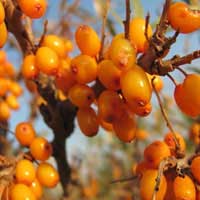 Full List of Fruits
Full List of Fruits  Sea-buckthorn
Sea-buckthornSea-buckthorn Fruit
Scientific name - Hippophae
The Hippophae falls under the category of deciduous shrubs inheriting from the family of Elaeagnaceae, they are sea-buckthorns having branches that are thick and firm and has thorns. The plants are of two types male and female, the male plants contain brownish flowers which involve in producing wind-distributed pollen, whereas the female plants bear fruits similar to that of the orange berry, the fruit has a diameter of 6-9 millimeters which is 0.24-0.35 inches, the texture is soft, fleshy and contains abundant oil content in it, the fruits juice and the pulp help in the production of foods and also beverages, the roots come out fast and are elongated which involves in non-leguminous nitrogen fixation in the soils nearby.
![]() Nutritional Value of Sea-buckthorn
Nutritional Value of Sea-buckthorn
| Vitamin E (up to 180 mg) |
| Vitamin C (50-900 mg) |
| Vitamin A (up to 60 mcg) |
| Carotenoids: beta-carotene, gamma-carotene, lycopene (total 60-180 mg) |
| Vitamin B1 (up to 35 mcg) |
| Vitamin B2 (up to 55 mcg) |
| Folate (up to 80 mcg ) |
| Carbohydrates (up to 3.6g) |
The fruits are involved in the preparation of pies, jams, lotions, fruit wines and liquors, both the juice and also the pulp are used in the preparation of many foods and also beverages, they also aid in the preparation of juice drinks in the country of Mongolia and some concentrates also, they are used as baby food as they are very nutritious, the sea-buckthorn oils help in the production of many commercial products such as the cosmetic products and also nutritional supplements, they are involved in the production of juice, sports drinks, jellies, ice cream, cosmetics and medicines lately.
![]() Health Benefits of Sea-buckthorn
Health Benefits of Sea-buckthorn
The trees bark and also their leaves aid in curing diarrhea and also several dermatological problems. The oil obtained is edible as well used to apply on the skin; they enhance the skin by softening them. These fruits are used in the production of Indian, Chinese and Tibetan medicines, these fruits help in treating the pulmonary, gastrointestinal, cardiac, blood or metabolic complications. The research which made use of the leaf as a substitute of tea was given to a mice which produced anti-obesity properties in it. The fruit additionally contains a lot of medical applications such as the cardiovascular, immunity, anticancer, memory, growth, anti-inflammatory, and enhances skin health.
The harvesting process is a tedious one as there are thick thorns present between the berries in all the branches. The mostly used technique for harvesting is to detach the branch but this technique is not good for the shrubs and also minimizes further harvests, the detached branch is allowed to freeze, this makes the berries to quickly fall. Fruits are squeezed for the removal of 95 percent of leaves along with the debris; the fruits reach a molten stage lightly at the outer surface since these processes are conducted at an ambient temperature of 20 degrees. The fruits or else the squeezed pulp are made to freeze for the purpose of storing.


















